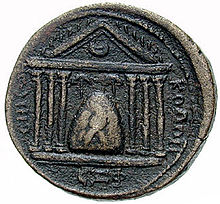Baetylus

Baetylus (also Baetyl, Bethel, or Betyl, from Semitic bet el "house of god"; compare Bethel, Beit El) are sacred stones which were supposedly endowed with life, or gave access to a deity. According to ancient sources, at least some of these objects of worship were meteorites, which were dedicated to the gods or revered as symbols of the gods themselves.[1]
Other accounts suggest contact with them could give access to
They had a role in most regions of the ancient Near East and Greek and Roman religion, as well as other cultures.
Examples
With various other sites around the Mediterranean, they were a feature of the Neolithic temple site of Tas-Silġ and other sites on Malta and Gozo.[5] The Hittites worshipped sacred stones called Huwasi stones.
In the
When Jacob awoke from his sleep, he thought, "Surely the Lord is in this place, and I was not aware of it." He was afraid and said, "How awesome is this place! This is none other than the house of God; this is the gate of heaven." Early the next morning Jacob took the stone he had placed under his head and set it up as a pillar and poured oil on top of it. He called that place Bethel, though the city used to be called Luz. ....
Then Jacob made a vow, saying, "If God will be with me and will watch over me on this journey I am taking and will give me food to eat and clothes to wear so that I return safely to my father's household, then the Lord will be my God and this stone that I have set up as a pillar will be God's house, and of all that you give me I will give you a tenth."
—NIV
In
In the Phoenician mythology related by Sanchuniathon, one of the sons of Uranus was named Baetylus.[9] The worship of baetyls was widespread in the Phoenician colonies, including Tyre, Sidon, and Carthage, even after the adoption of Christianity, and was denounced by Augustine of Hippo.
A similar practice survives today with the Kaaba's Black Stone, which was sacred to the polytheists before Islam.[10]
Ancient Greece and Rome
In

In Rome, there was the stone effigy of Cybele, called Mater Idaea Deum, that had been ceremoniously brought from Pessinus in Asia Minor in 204 BC.[9] The emperor Elagabalus who reigned from 218 until 222 (and was probably a teenager for all his reign) came from Syria and was already the hereditary high priest of the cult of the god Elagabalus there. Once made emperor he brought the god's baetyl to Rome with great ceremony, and built the Elagabalium to house it. It seems to have been a conical meteorite.
In some cases an attempt was made to give a more regular form to the original shapeless stone: thus Apollo Agyieus was represented by a conical pillar with a pointed end, Zeus Meilichius in the form of a pyramid.
According to
Other famous baetylic idols were those in the temples of Zeus Casius at Seleucia Pieria, and of Zeus Teleios at Tegea. Even in the declining years of paganism, these idols still retained their significance, as is shown by the attacks upon them by ecclesiastical writers.[9]
See also
- Asherah pole, Canaanite sacred tree or pole honouring Asherah, consort of El
- Bema and bimah, elevated platform
- Bethel (god)
- Benben
- Black Stone, the venerated stone at Kaaba
- Ceremonial pole
- High place, raised place of worship
- List of Greek mythological figures
- Kami, central objects of worship for Shinto, some of which are natural phenomena and natural objects such as stones.
- Lingam, abstract representation of the Hindu deity Shiva
- Banalinga, stones naturally worn to ovoid shapes in river beds in India
- Matzevah
- Menhir
- Pole worship
- Shaligram, river-bed fossils in India, considered holy
- Stele, stone or wooden slab erected as a monument
- Turbah, small clay or earthen slabs used by Twelver Muslims
Notes
- ^ Chisholm 1911 cites Pliny's Natural History xvii. 9; Photios I of Constantinople, Myriobiblon, Codex 242.
- ^ a b Doniger 2000, p. 106.
- ISBN 9781850759355) attempts to make distinctions based on ancient sources, arguably with little success.
- ^ "The Betyls of Petra", Robert Wenning
- ISBN 9789027272539
- ^ Marinatos makes the connection with baetyls
- ^ Marinatos, Nanno (2004), "The Character of Minoan Epiphanies", Illinois Classical Studies, vol. 29, 2004, pp. 32–39, JSTOR. Accessed 18 February 2021.
- ^ MacGillivray, Alexander, and Hugh Sackett. "The Palaikastro Kouros: the Cretan God as a Young Man", p. 166, British School at Athens Studies, vol. 6, 2000, pp. 165–169. JSTOR. Accessed 22 February 2021
- ^ a b c One or more of the preceding sentences incorporates text from a publication now in the public domain: Chisholm, Hugh, ed. (1911). "Baetylus". Encyclopædia Britannica. Vol. 3 (11th ed.). Cambridge University Press. pp. 191–192. This has further references:
- Friedrich Münter, Über die vom Himmel gefallenen Steine (1805).
- Bösigk, De Baetyliis (1854).
- the exhaustive article by François Lenormant in Charles Victor Daremberg and Edmond Saglio's Dictionnaire des Antiquités Grecques et Romaines
- ^ Ibn Ishaq (1964). The life of Muhammad. The Folio Society.
- ^ Chisholm 1911 cites Etymologicum Magnum, s.v.
- ^ Chisholm 1911 cites Pausanias X. 24.
- OCLC 11108482.
References
- Doniger, Wendy (2000), Merriam-Webster's Encyclopedia of World Religions, Springfield, Mass.: Merriam-Webster, p. 106, ISBN 0-87779-044-2
- Palmer, Robert Everett Allen (1997), Rome and Carthage at Peace, Stuttgart: F. Steiner, p. 99, ISBN 3-515-07040-0
Further reading
- "Baetyl" Jona Lendering, Livius.org
- Uta Kron: "Heilige Steine", in: Kotinos. Festschrift für Erika Simon, Mainz 1992, S. 56–70, ISBN 3-8053-1425-6
